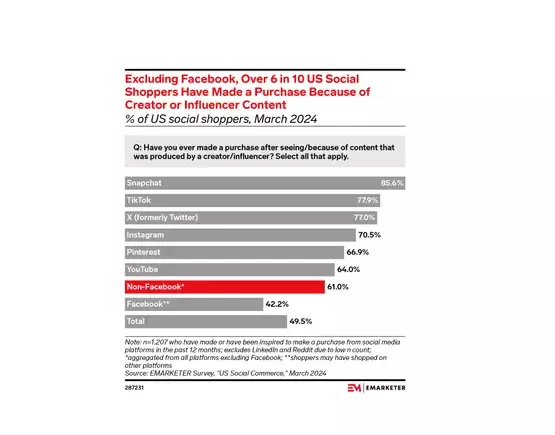In the realm of social media, Snapchat continues to assert its dominance as a crucial platform for shopping discovery. A recently published report by eMarketer provides compelling evidence of Snapchat’s role in influencing consumer purchasing decisions, particularly among younger demographics. This report reveals that 85.6% of Snapchat users have made purchases based on influencer content presented within the app. This statistic not only points to Snapchat’s effectiveness as a marketing tool but also underlines the growing significance of social media platforms in shaping consumer behavior.
When juxtaposed with other major platforms such as TikTok, Instagram, and even YouTube, Snapchat shines brightly as the frontrunner in terms of user purchasing actions spurred by influencer showcases. Surprisingly, YouTube, known for its vast array of content creators like MrBeast and Logan Paul, ranks lower in influencing consumer purchases. This disconnect raises intriguing questions about the nature of engagement on different platforms. While content creators on YouTube have successfully established retail ventures, they seem to lack the immediate purchasing influence that Snapchat offers — perhaps hinting at the unique environment and user engagement patterns on the platform.
eMarketer’s survey highlights a remarkable disparity in the effectiveness of influencer-driven shopping across age groups. Among the Gen Z demographic, a staggering 82% of individuals aged 15 to 26 reported making purchases based on influencer content. In stark contrast, only 18.8% of baby boomers participated in similar shopping behaviors. It’s particularly noteworthy that even Gen X shoppers, who traditionally engage with brands differently, demonstrate a considerable inclination toward influencer-driven purchases at a rate of 40.8%. These insights illustrate that while generational preferences are distinct, the power of influencer marketing is permeating various age cohorts.
On the flip side, Facebook finds itself at the bottom of the scale when it comes to creator-driven shopping influence. The platform’s structural design does not inherently foster deep connections between creators and consumers or efficiently promote relevant trends. This limitation may account for the lower engagement and influencer efficacy observed on Facebook compared to Snapchat. Businesses aiming to leverage influencer marketing should therefore reassess their investments in social media platforms, considering where their target audiences are most engaged.
The insights from this report signal exciting possibilities for brands looking to connect with consumers through strategic influencer partnerships. As Snapchat users increasingly embrace online shopping, brands have a unique opportunity to enhance their visibility and influence through relevant collaborations within the app. Engaging with niche creators who resonate with younger demographics can amplify campaign effectiveness significantly. As social shopping continues to evolve, understanding the dynamics of each platform will be essential for marketers seeking to maximize their outreach in this digital age.

